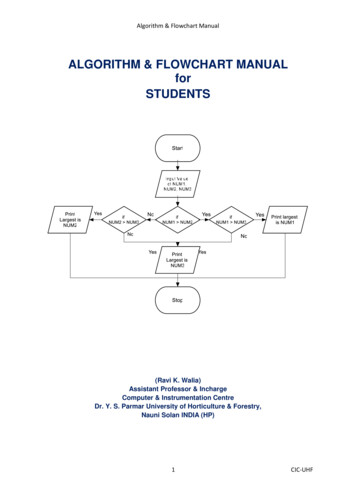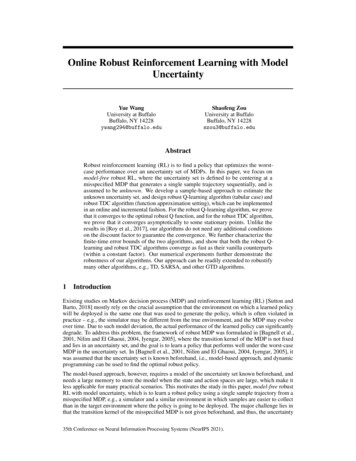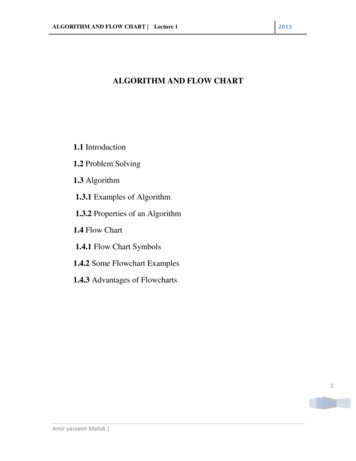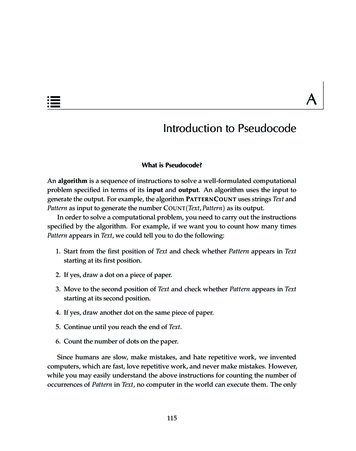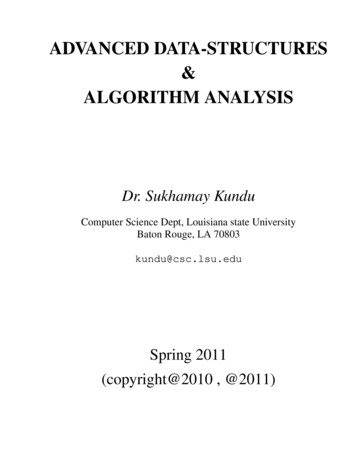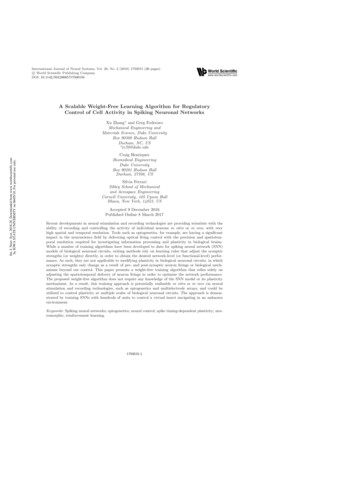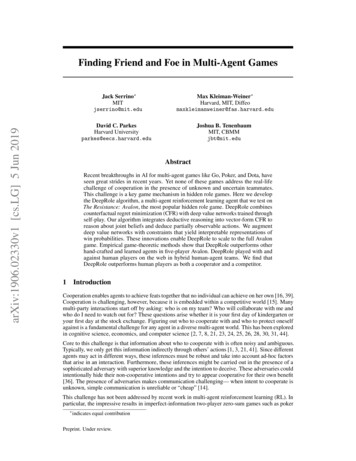
Transcription
The Algorithm Design ManualSecond Edition
Steven S. SkienaThe Algorithm Design ManualSecond Edition123
Steven S. SkienaDepartment of Computer ScienceState University of New Yorkat Stony BrookNew York, USAskiena@cs.sunysb.eduISBN: 978-1-84800-069-8DOI: 10.1007/978-1-84800-070-4e-ISBN: 978-1-84800-070-4British Library Cataloguing in Publication DataA catalogue record for this book is available from the British LibraryLibrary of Congress Control Number: 2008931136c Springer-Verlag London Limited 2008 Apart from any fair dealing for the purposes of research or private study, or criticism or review, as permittedunder the Copyright, Designs and Patents Act 1988, this publication may only be reproduced, stored or transmitted, in any form or by any means, with the prior permission in writing of the publishers, or in the case ofreprographic reproduction in accordance with the terms of licenses issued by the Copyright Licensing Agency.Enquiries concerning reproduction outside those terms should be sent to the publishers.The use of registered names, trademarks, etc., in this publication does not imply, even in the absence of aspecific statement, that such names are exempt from the relevant laws and regulations and therefore free forgeneral use.The publisher makes no representation, express or implied, with regard to the accuracy of the informationcontained in this book and cannot accept any legal responsibility or liability for any errors or omissions thatmay be made.Printed on acid-free paperSpringer Science Business Mediaspringer.com
PrefaceMost professional programmers that I’ve encountered are not well prepared totackle algorithm design problems. This is a pity, because the techniques of algorithmdesign form one of the core practical technologies of computer science. Designingcorrect, efficient, and implementable algorithms for real-world problems requiresaccess to two distinct bodies of knowledge: Techniques – Good algorithm designers understand several fundamental algorithm design techniques, including data structures, dynamic programming,depth-first search, backtracking, and heuristics. Perhaps the single most important design technique is modeling, the art of abstracting a messy real-worldapplication into a clean problem suitable for algorithmic attack. Resources – Good algorithm designers stand on the shoulders of giants.Rather than laboring from scratch to produce a new algorithm for every task,they can figure out what is known about a particular problem. Rather thanre-implementing popular algorithms from scratch, they seek existing implementations to serve as a starting point. They are familiar with many classicalgorithmic problems, which provide sufficient source material to model mostany application.This book is intended as a manual on algorithm design, providing access tocombinatorial algorithm technology for both students and computer professionals.It is divided into two parts: Techniques and Resources. The former is a generalguide to techniques for the design and analysis of computer algorithms. The Resources section is intended for browsing and reference, and comprises the catalogof algorithmic resources, implementations, and an extensive bibliography.
viPREFACETo the ReaderI have been gratified by the warm reception the first edition of The Algorithm Design Manual has received since its initial publication in 1997. It has been recognizedas a unique guide to using algorithmic techniques to solve problems that often arisein practice. But much has changed in the world since the The Algorithm DesignManual was first published over ten years ago. Indeed, if we date the origins ofmodern algorithm design and analysis to about 1970, then roughly 30% of modernalgorithmic history has happened since the first coming of The Algorithm DesignManual.Three aspects of The Algorithm Design Manual have been particularly beloved:(1) the catalog of algorithmic problems, (2) the war stories, and (3) the electroniccomponent of the book. These features have been preserved and strengthened inthis edition: The Catalog of Algorithmic Problems – Since finding out what is known aboutan algorithmic problem can be a difficult task, I provide a catalog of the75 most important problems arising in practice. By browsing through thiscatalog, the student or practitioner can quickly identify what their problem iscalled, what is known about it, and how they should proceed to solve it. To aidin problem identification, we include a pair of “before” and “after” pictures foreach problem, illustrating the required input and output specifications. Oneperceptive reviewer called my book “The Hitchhiker’s Guide to Algorithms”on the strength of this catalog.The catalog is the most important part of this book. To update the catalogfor this edition, I have solicited feedback from the world’s leading experts oneach associated problem. Particular attention has been paid to updating thediscussion of available software implementations for each problem. War Stories – In practice, algorithm problems do not arise at the beginning ofa large project. Rather, they typically arise as subproblems when it becomesclear that the programmer does not know how to proceed or that the currentsolution is inadequate.To provide a better perspective on how algorithm problems arise in the realworld, we include a collection of “war stories,” or tales from our experiencewith real problems. The moral of these stories is that algorithm design andanalysis is not just theory, but an important tool to be pulled out and usedas needed.This edition retains all the original war stories (with updates as appropriate)plus additional new war stories covering external sorting, graph algorithms,simulated annealing, and other topics. Electronic Component – Since the practical person is usually looking for aprogram more than an algorithm, we provide pointers to solid implementations whenever they are available. We have collected these implementations
PREFACEat one central website site (http://www.cs.sunysb.edu/ algorith) for easy retrieval. We have been the number one “Algorithm” site on Google prettymuch since the initial publication of the book.Further, we provide recommendations to make it easier to identify the correctcode for the job. With these implementations available, the critical issuein algorithm design becomes properly modeling your application, more sothan becoming intimate with the details of the actual algorithm. This focuspermeates the entire book.Equally important is what we do not do in this book. We do not stress themathematical analysis of algorithms, leaving most of the analysis as informal arguments. You will not find a single theorem anywhere in this book. When moredetails are needed, the reader should study the cited programs or references. Thegoal of this manual is to get you going in the right direction as quickly as possible.To the InstructorThis book covers enough material for a standard Introduction to Algorithms course.We assume the reader has completed the equivalent of a second programmingcourse, typically titled Data Structures or Computer Science II.A full set of lecture slides for teaching this course is available online athttp://www.algorist.com . Further, I make available online audio and video lecturesusing these slides to teach a full-semester algorithm course. Let me help teach yourcourse, by the magic of the Internet!This book stresses design over analysis. It is suitable for both traditional lecturecourses and the new “active learning” method, where the professor does not lecturebut instead guides student groups to solve real problems. The “war stories” providean appropriate introduction to the active learning method.I have made several pedagogical improvements throughout the book. Textbookoriented features include: More Leisurely Discussion – The tutorial material in the first part of the bookhas been doubled over the previous edition. The pages have been devoted tomore thorough and careful exposition of fundamental material, instead ofadding more specialized topics. False Starts – Algorithms textbooks generally present important algorithmsas a fait accompli, obscuring the ideas involved in designing them and thesubtle reasons why other approaches fail. The war stories illustrate such development on certain applied problems, but I have expanded such coverageinto classical algorithm design material as well. Stop and Think – Here I illustrate my thought process as I solve a topicspecific homework problem—false starts and all. I have interspersed suchvii
viiiPREFACEproblem blocks throughout the text to increase the problem-solving activityof my readers. Answers appear immediately following each problem. More and Improved Homework Problems – This edition of The AlgorithmDesign Manual has twice as many homework exercises as the previous one.Exercises that proved confusing or ambiguous have been improved or replaced. Degree of difficulty ratings (from 1 to 10) have been assigned to allproblems. Self-Motivating Exam Design – In my algorithms courses, I promise the students that all midterm and final exam questions will be taken directly fromhomework problems in this book. This provides a “student-motivated exam,”so students know exactly how to study to do well on the exam. I have carefullypicked the quantity, variety, and difficulty of homework exercises to make thiswork; ensuring there are neither too few or too many candidate problems. Take-Home Lessons – Highlighted “take-home” lesson boxes scatteredthroughout the text emphasize the big-picture concepts to be gained fromthe chapter. Links to Programming Challenge Problems – Each chapter’s exercises willcontain links to 3-5 relevant “Programming Challenge” problems fromhttp://www.programming-challenges.com. These can be used to add a programming component to paper-and-pencil algorithms courses. More Code, Less Pseudo-code – More algorithms in this book appear as code(written in C) instead of pseudo-code. I believe the concreteness and reliability of actual tested implementations provides a big win over less formalpresentations for simple algorithms. Full implementations are available forstudy at http://www.algorist.com . Chapter Notes – Each tutorial chapter concludes with a brief notes section,pointing readers to primary sources and additional references.AcknowledgmentsUpdating a book dedication after ten years focuses attention on the effects of time.Since the first edition, Renee has become my wife and then the mother of ourtwo children, Bonnie and Abby. My father has left this world, but Mom and mybrothers Len and Rob remain a vital presence in my life. I dedicate this book tomy family, new and old, here and departed.I would like to thank several people for their concrete contributions to thisnew edition. Andrew Gaun and Betson Thomas helped in many ways, particularlyin building the infrastructure for the new http://www.cs.sunysb.edu/ algorithanddealing with a variety of manuscript preparation issues. David Gries offered valuable feedback well beyond the call of duty. Himanshu Gupta and Bin Tang bravely
PREFACEtaught courses using a manuscript version of this edition. Thanks also to mySpringer-Verlag editors, Wayne Wheeler and Allan Wylde.A select group of algorithmic sages reviewed sections of the Hitchhiker’s guide,sharing their wisdom and alerting me to new developments. Thanks to:Ami Amir, Herve Bronnimann, Bernard Chazelle, Chris Chu, ScottCotton, Yefim Dinitz, Komei Fukuda, Michael Goodrich, Lenny Heath,Cihat Imamoglu, Tao Jiang, David Karger, Giuseppe Liotta, AlbertMao, Silvano Martello, Catherine McGeoch, Kurt Mehlhorn, ScottA. Mitchell, Naceur Meskini, Gene Myers, Gonzalo Navarro, StephenNorth, Joe O’Rourke, Mike Paterson, Theo Pavlidis, Seth Pettie, MichelPocchiola, Bart Preneel, Tomasz Radzik, Edward Reingold, FrankRuskey, Peter Sanders, Joao Setubal, Jonathan Shewchuk, RobertSkeel, Jens Stoye, Torsten Suel, Bruce Watson, and Uri Zwick.Several exercises were originated by colleagues or inspired by other texts. Reconstructing the original sources years later can be challenging, but credits for eachproblem (to the best of my recollection) appear on the website.It would be rude not to thank important contributors to the original edition.Ricky Bradley and Dario Vlah built up the substantial infrastructure required forthe WWW site in a logical and extensible manner. Zhong Li drew most of thecatalog figures using xfig. Richard Crandall, Ron Danielson, Takis Metaxas, DaveMiller, Giri Narasimhan, and Joe Zachary all reviewed preliminary versions of thefirst edition; their thoughtful feedback helped to shape what you see here.Much of what I know about algorithms I learned along with my graduatestudents. Several of them (Yaw-Ling Lin, Sundaram Gopalakrishnan, Ting Chen,Francine Evans, Harald Rau, Ricky Bradley, and Dimitris Margaritis) are the realheroes of the war stories related within. My Stony Brook friends and algorithmcolleagues Estie Arkin, Michael Bender, Jie Gao, and Joe Mitchell have alwaysbeen a pleasure to work and be with. Finally, thanks to Michael Brochstein andthe rest of the city contingent for revealing a proper life well beyond Stony Brook.CaveatIt is traditional for the author to magnanimously accept the blame for whateverdeficiencies remain. I don’t. Any errors, deficiencies, or problems in this book aresomebody else’s fault, but I would appreciate knowing about them so as to determine who is to blame.Steven S. SkienaDepartment of Computer ScienceStony Brook UniversityStony Brook, NY 11794-4400http://www.cs.sunysb.edu/ skienaApril 2008ix
ContentsIPractical Algorithm Design1 Introduction to Algorithm Design1.1 Robot Tour Optimization . .1.2 Selecting the Right Jobs . . .1.3 Reasoning about Correctness1.4 Modeling the Problem . . . .1.5 About the War Stories . . . .1.6 War Story: Psychic Modeling1.7 Exercises . . . . . . . . . . . .1.35911192223272 Algorithm Analysis2.1 The RAM Model of Computation . . . .2.2 The Big Oh Notation . . . . . . . . . . .2.3 Growth Rates and Dominance Relations2.4 Working with the Big Oh . . . . . . . .2.5 Reasoning About Efficiency . . . . . . .2.6 Logarithms and Their Applications . . .2.7 Properties of Logarithms . . . . . . . . .2.8 War Story: Mystery of the Pyramids . .2.9 Advanced Analysis (*) . . . . . . . . . .2.10 Exercises . . . . . . . . . . . . . . . . . .31313437404146505154573 Data Structures3.1 Contiguous vs. Linked Data Structures . . . . . . . . . . . . . . .6566.
xiiCONTENTS3.23.33.43.53.63.73.83.93.104 Sorting4.14.24.34.44.54.64.74.84.94.104.11Stacks and Queues . . . . . . . . . .Dictionaries . . . . . . . . . . . . . .Binary Search Trees . . . . . . . . . .Priority Queues . . . . . . . . . . . .War Story: Stripping TriangulationsHashing and Strings . . . . . . . . .Specialized Data Structures . . . . .War Story: String ’em Up . . . . . .Exercises . . . . . . . . . . . . . . . .717277838589939498and SearchingApplications of Sorting . . . . . . . . . . . . .Pragmatics of Sorting . . . . . . . . . . . . . .Heapsort: Fast Sorting via Data Structures .War Story: Give me a Ticket on an AirplaneMergesort: Sorting by Divide-and-Conquer .Quicksort: Sorting by Randomization . . . .Distribution Sort: Sorting via Bucketing . . .War Story: Skiena for the Defense . . . . . .Binary Search and Related Algorithms . . . .Divide-and-Conquer . . . . . . . . . . . . . . .Exercises . . . . . . . . . . . . . . . . . . . . .1031041071081181201231291311321351395 Graph Traversal5.1 Flavors of Graphs . . . . . . . . . . . . . . .5.2 Data Structures for Graphs . . . . . . . . .5.3 War Story: I was a Victim of Moore’s Law5.4 War Story: Getting the Graph . . . . . . . .5.5 Traversing a Graph . . . . . . . . . . . . . .5.6 Breadth-First Search . . . . . . . . . . . . .5.7 Applications of Breadth-First Search . . . .5.8 Depth-First Search . . . . . . . . . . . . . .5.9 Applications of Depth-First Search . . . . .5.10 Depth-First Search on Directed Graphs . .5.11 Exercises . . . . . . . . . . . . . . . . . . . .1451461511551581611621661691721781846 Weighted Graph Algorithms6.1 Minimum Spanning Trees . . . . . . . .6.2 War Story: Nothing but Nets . . . . . .6.3 Shortest Paths . . . . . . . . . . . . . . .6.4 War Story: Dialing for Documents . . .6.5 Network Flows and Bipartite Matching6.6 Design Graphs, Not Algorithms . . . . .6.7 Exercises . . . . . . . . . . . . . . . . . .191192202205212217222225.
CONTENTS7 Combinatorial Search and Heuristic Methods7.1 Backtracking . . . . . . . . . . . . . . . . . .7.2 Search Pruning . . . . . . . . . . . . . . . .7.3 Sudoku . . . . . . . . . . . . . . . . . . . . .7.4 War Story: Covering Chessboards . . . . . .7.5 Heuristic Search Methods . . . . . . . . . .7.6 War Story: Only it is Not a Radio . . . . .7.7 War Story: Annealing Arrays . . . . . . . .7.8 Other Heuristic Search Methods . . . . . .7.9 Parallel Algorithms . . . . . . . . . . . . . .7.10 War Story: Going Nowhere Fast . . . . . . .7.11 Exercises . . . . . . . . . . . . . . . . . . . .2302312382392442472602632662672682708 Dynamic Programming8.1 Caching vs. Computation . . . . . . . . . . .8.2 Approximate String Matching . . . . . . . . .8.3 Longest Increasing Sequence . . . . . . . . . .8.4 War Story: Evolution of the Lobster . . . . .8.5 The Partition Problem . . . . . . . . . . . . .8.6 Parsing Context-Free Grammars . . . . . . .8.7 Limitations of Dynamic Programming: TSP .8.8 War Story: What’s Past is Prolog . . . . . . .8.9 War Story: Text Compression for Bar Codes8.10 Exercises . . . . . . . . . . . . . . . . . . . . .2732742802892912942983013043073109 Intractable Problems and Approximation Algorithms9.1 Problems and Reductions . . . . . . . . . . . . . . .9.2 Reductions for Algorithms . . . . . . . . . . . . . . .9.3 Elementary Hardness Reductions . . . . . . . . . . .9.4 Satisfiability . . . . . . . . . . . . . . . . . . . . . . .9.5 Creative Reductions . . . . . . . . . . . . . . . . . .9.6 The Art of Proving Hardness . . . . . . . . . . . . .9.7 War Story: Hard Against the Clock . . . . . . . . . .9.8 War Story: And Then I Failed . . . . . . . . . . . . .9.9 P vs. NP . . . . . . . . . . . . . . . . . . . . . . . . .9.10 Dealing with NP-complete Problems . . . . . . . . .9.11 Exercises . . . . . . . . . . . . . . . . . . . . . . . . .31631731932332833033433733934134435010 How to Design AlgorithmsIIThe Hitchhiker’s Guide to Algorithms11 A Catalog of Algorithmic Problems356361363xiii
xivCONTENTS12 Data Structures12.1 Dictionaries . . . . . . .12.2 Priority Queues . . . . .12.3 Suffix Trees and Arrays .12.4 Graph Data Structures .12.5 Set Data Structures . . .12.6 Kd-Trees . . . . . . . . .36636737337738138538913 Numerical Problems13.1 Solving Linear Equations . . . . . . . . . . . .13.2 Bandwidth Reduction . . . . . . . . . . . . .13.3 Matrix Multiplication . . . . . . . . . . . . . .13.4 Determinants and Permanents . . . . . . . . .13.5 Constrained and Unconstrained Optimization13.6 Linear Programming . . . . . . . . . . . . . .13.7 Random Number Generation . . . . . . . . .13.8 Factoring and Primality Testing . . . . . . . .13.9 Arbitrary-Precision Arithmetic . . . . . . . .13.10 Knapsack Problem . . . . . . . . . . . . . . .13.11 Discrete Fourier Transform . . . . . . . . . .39339539840140440741141542042342743114 Combinatorial Problems14.1 Sorting . . . . . . . . . .14.2 Searching . . . . . . . . .14.3 Median and Selection . .14.4 Generating Permutations14.5 Generating Subsets . . .14.6 Generating Partitions . .14.7 Generating Graphs . . .14.8 Calendrical Calculations14.9 Job Scheduling . . . . . .14.10 Satisfiability . . . . . . .43443644144544845245646046546847215 Graph Problems: Polynomial-Time15.1 Connected Components . . . . .15.2 Topological Sorting . . . . . . . .15.3 Minimum Spanning Tree . . . . .15.4 Shortest Path . . . . . . . . . . .15.5 Transitive Closure and Reduction15.6 Matching . . . . . . . . . . . . . .15.7 Eulerian Cycle/Chinese Postman15.8 Edge and Vertex Connectivity . .15.9 Network Flow . . . . . . . . . . .15.10 Drawing Graphs Nicely . . . . . .475477481484489495498502505509513.
CONTENTS15.11 Drawing Trees . . . . . . . . . . . . . . . . . . . . . . . . . . . . .15.12 Planarity Detection and Embedding . . . . . . . . . . . . . . . .16 Graph Problems: Hard Problems16.1 Clique . . . . . . . . . . . . . .16.2 Independent Set . . . . . . . .16.3 Vertex Cover . . . . . . . . . .16.4 Traveling Salesman Problem .16.5 Hamiltonian Cycle . . . . . .16.6 Graph Partition . . . . . . . .16.7 Vertex Coloring . . . . . . . .16.8 Edge Coloring . . . . . . . . .16.9 Graph Isomorphism . . . . . .16.10 Steiner Tree . . . . . . . . . .16.11 Feedback Edge/Vertex Set . .517520.52352552853053353854154454855055555917 Computational Geometry17.1 Robust Geometric Primitives .17.2 Convex Hull . . . . . . . . . . .17.3 Triangulation . . . . . . . . . .17.4 Voronoi Diagrams . . . . . . . .17.5 Nearest Neighbor Search . . . .17.6 Range Search . . . . . . . . . .17.7 Point Location . . . . . . . . . .17.8 Intersection Detection . . . . .17.9 Bin Packing . . . . . . . . . . .17.10 Medial-Axis Transform . . . . .17.11 Polygon Partitioning . . . . . .17.12 Simplifying Polygons . . . . . .17.13 Shape Similarity . . . . . . . . .17.14 Motion Planning . . . . . . . .17.15 Maintaining Line Arrangements17.16 Minkowski Sum . . . . . . . . 17String ProblemsSet Cover . . . . . . . . . . . . . . . . . . .Set Packing . . . . . . . . . . . . . . . . .String Matching . . . . . . . . . . . . . . .Approximate String Matching . . . . . . .Text Compression . . . . . . . . . . . . . .Cryptography . . . . . . . . . . . . . . . .Finite State Machine Minimization . . . .Longest Common Substring/SubsequenceShortest Common Superstring . . . . . . .62062162562863163764164665065418 Set and18.118.218.318.418.518.618.718.818.9xv
xviCONTENTS19 Algorithmic Resources19.1 Software Systems . . . . . . . . .19.2 Data Sources . . . . . . . . . . . .19.3 Online Bibliographic Resources .19.4 Professional Consulting Services .657657663663664Bibliography665Index709
1Introduction to Algorithm DesignWhat is an algorithm? An algorithm is a procedure to accomplish a specific task.An algorithm is the idea behind any reasonable computer program.To be interesting, an algorithm must solve a general, well-specified problem. Analgorithmic problem is specified by describing the complete set of instances it mustwork on and of its output after running on one of these instances. This distinction,between a problem and an instance of a problem, is fundamental. For example, thealgorithmic problem known as sorting is defined as follows:Problem: SortingInput: A sequence of n keys a1 , . . . , an .Output: The permutation (reordering) of the input sequence such that a 1 a 2 · · · a n 1 a n .An instance of sorting might be an array of names, like {Mike, Bob, Sally, Jill,Jan}, or a list of numbers like {154, 245, 568, 324, 654, 324}. Determining thatyou are dealing with a general problem is your first step towards solving it.An algorithm is a procedure that takes any of the possible input instancesand transforms it to the desired output. There are many different algorithms forsolving the problem of sorting. For example, insertion sort is a method for sortingthat starts with a single element (thus forming a trivially sorted list) and thenincrementally inserts the remaining elements so that the list stays sorted. Thisalgorithm, implemented in C, is described below:S.S. Skiena, The Algorithm Design Manual, 2nd ed., DOI: 10.1007/978-1-84800-070-4 1,c Springer-Verlag London Limited 2008
41. INTRODUCTION TO ALGORITHM DESIGNI NI NI NE IE IE IE IE IE IE IE IE IE IS E R T I O N S OS E R T I O N S OS E R T I O N S ON S R T I O N S ON R S T I O N S ON R S T I O N S OI N R S T O N S OI N O R S T N S OI N N O R S T S OI N N O R S S T OI N N O O R S S TI N N O O R R S SI N N O O R R S SRRRRRRRRRRRTTTTTTTTTTTTTTTFigure 1.1: Animation of insertion sort in action (time flows down)insertion sort(item s[], int n){int i,j;/* counters */for (i 1; i n; i ) {j i;while ((j 0) && (s[j] s[j-1])) {swap(&s[j],&s[j-1]);j j-1;}}}An animation of the logical flow of this algorithm on a particular instance (theletters in the word “INSERTIONSORT”) is given in Figure 1.1Note the generality of this algorithm. It works just as well on names as it doeson numbers, given the appropriate comparison operation ( ) to test which of thetwo keys should appear first in sorted order. It can be readily verified that thisalgorithm correctly orders every possible input instance according to our definitionof the sorting problem.There are three desirable properties for a good algorithm. We seek algorithmsthat are correct and efficient, while being easy to implement. These goals may notbe simultaneously achievable. In industrial settings, any program that seems togive good enough answers without slowing the application down is often acceptable,regardless of whether a better algorithm exists. The issue of finding the best possibleanswer or achieving maximum efficiency usually arises in industry only after seriousperformance or legal troubles.In this chapter, we will focus on the issues of algorithm correctness, and defer adiscussion of efficiency concerns to Chapter 2. It is seldom obvious whether a given
1.1ROBOT TOUR OPTIMIZATION0081726354Figure 1.2: A good instance for the nearest-neighbor heuristicalgorithm correctly solves a given problem. Correct algorithms usually come witha proof of correctness, which is an explanation of why we know that the algorithmmust take every instance of the problem to the desired result. However, before we gofurther we demonstrate why “it’s obvious” never suffices as a proof of correctness,and is usually flat-out wrong.1.1Robot Tour OptimizationLet’s consider a problem that arises often in manufacturing, transportation, andtesting applications. Suppose we are given a robot arm equipped with a tool, say asoldering iron. In manufacturing circuit boards, all the chips and other componentsmust be fastened onto the substrate. More specifically, each chip has a set of contactpoints (or wires) that must be soldered to the board. To program the robot armfor this job, we must first construct an ordering of the contact points so the robotvisits (and solders) the first contact point, then the second point, third, and soforth until the job is done. The robot arm then proceeds back to the first contactpoint to prepare for the next board, thus turning the tool-path into a closed tour,or cycle.Robots are expensive devices, so we want the tour that minimizes the time ittakes to assemble the circuit board. A reasonable assumption is that the robot armmoves with fixed speed, so the time to travel between two points is proportionalto their distance. In short, we must solve the following algorithm problem:Problem: Robot Tour OptimizationInput: A set S of n points in the plane.Output: What is the shortest cycle tour that visits each point in the set S?You are given the job of programming the robot arm. Stop right now and thinkup an algorithm to solve this problem. I’ll be happy to wait until you find one. . .5
61. INTRODUCTION TO ALGORITHM DESIGNSeveral algorithms might come to mind to solve this problem. Perhaps the mostpopular idea is the nearest-neighbor heuristic. Starting from some point p0 , we walkfirst to its nearest neighbor p1 . From p1 , we walk to its ne
This book is intended as a manual on algorithm design, providing access to combinatorial algorithm technology for both students and computer professionals. It is divided into two parts: Techniques and Resources. The former is a general guide to techniques for the design and analysis of computer algorithms. The Re-


